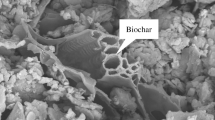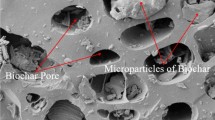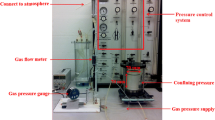Abstract
Purpose
Biochar has the characteristics of loose porosity, high specific surface area, and strong adsorption properties. Recently, the compacted biochar amended clay has been proposed as a sustainable alternative material for the final cover of landfills. However, the effect of biochar on saturated hydraulic conductivity (ksat) is not yet conclusive. The objective of this study was to determine the influence of biochar content on the permeability of biochar-clay mixed soils.
Materials and methods
The clay used in the study belongs to the low liquid limit clay. The biochar is produced by heating the rice straw under an oxygen-deficient condition at a temperature of 500 °C. To study the effect of biochar content on the permeability of biochar-clay mixed soils, the biochar-clay mixed soils with the mass percentage of biochar being 0%, 5%, 10%, 15%, and 20% were used. The saturated hydraulic conductivity of the biochar-clay mixed soils was measured by the head pressure control permeameter. Meanwhile, the micro-pore structure of the saturated biochar-clay mixed soils was obtained by the nuclear magnetic resonance (NMR) technique.
Results and discussion
It can be observed that the saturated hydraulic conductivity ksat of biochar-clay mixed soils increases linearly as the biochar content increases. The NMR results show that the T2 distribution curve of pure clay is a unimodal pattern, while the T2 distribution curve of biochar-clay mixed soils presents the bimodal pattern, where T2 is the transverse relaxation time, reflecting the pore size of the soil specimens. With the increase of biochar content, the T2 spectrum of the mixed soils moves slightly to the right, and T2 at main peak increases gradually, correspondingly the most probable pore size of biochar-clay mixed soils increases.
Conclusions
The pore size distribution of the soil was changed by the addition of biochar and subsequently affects the permeability of biochar-clay mixed soils. This study provides some useful suggestions for optimizing the pore structure of the biochar amended clay anti-seepage layer in the final cover of landfills.







Similar content being viewed by others
References
Ajayi AE, Holthusen D, Horn R (2016) Changes in microstructural behaviour and hydraulic functions of biochar amended soils. Soil Tillage Res 155:166–175
ASTM D422–63 (1998) Standard test method for particle-size analysis of soils. ASTM International, West Conshohocken PA
ASTM D1762–84 (2007) Standard test method for chemical analysis of wood charcoal. ASTM International, West Conshohocken PA
Bareither CA, Benson CH, Rohlf E M, IV JS (2020) Hydraulic and mechanical behavior of municipal solid waste and high-moisture waste mixtures. Waste Manag 105:540–549
Barnes RT, Gallagher ME, Masiello CA, Liu ZL (2014) Biochar-induced changes in soil hydraulic conductivity and dissolved nutrient fluxes constrained by laboratory experiments. PLoS ONE 9(9):e108340 1-9
Chen M, Dai J, Liu X, Kang Y, Qin MJ, Wang ZT (2019) Contributions of pore-throat size distribution to reservoir quality and fluid distribution from NMR and MIP in tight sandy conglomerate reservoirs. Arab J Geosci 12(1):1–12
Coates GR, Xiao LL, Prammer MG (1999) NMR logging principles and application. Halliburton Energy Services Publication, Houston
Chen B, Sun DA, Gao Y, Li J (2017) Experimental study of pore-size distribution of Shanghai soft clay. Rock Soil Mech 38(9):2523–2530
Devereux RC, Sturrock CJ, Mooney SJ (2012) The effects of biochar on soil physical properties and winter wheat growth. Earth and Environmental Science Transactions of the Royal Society of Edinburgh 103(1):13–18
Dunn KJ, Bergman DJ, Latorraca GA (2002) Nuclear magnetic resonance petrophysical and logging applications. Pergamon
Fang T, Zhang LK, Liu NG, Zhang LQ, Wang WM, Yu L, Li C, LeiYH (2018) Quantitative characterization of pore structure of the Carboniferous–Permian tight sandstone gas reservoirs in eastern Linqing depression by using NMR technique. Petroleum Research 3(2):110–123
Fei YH, She DL, Gao L (2019) Micro-CT assessment on the soil structure and hydraulic characteristics of saline/sodic soils subjected to short-term amendment. Soil Tillage Research 193(10):59–70
GB 51220–2017 (2017) Technical code for municipal solid waste sanitary landfill closure. China Building Industry Press, Beijing
Garg A, Ng CWW (2015) Investigation of soil density effect on suction induced due to root water uptake by Schefflera heptaphylla. J Plant Nutr Soil Sci 178(4):586–591
Horn R, Peng XH, Fleige H, Jose D (2014) Pore rigidity in structured soils—only a theoretical boundary condition for hydraulic properties? Soil Science and Plant Nutrition 60(1):3–14
He YB, Gu F, Xu C, Wang Y (2019) Assessing of the influence of organic and inorganic amendments on the physical-chemical properties of a red soil (Ultisol) quality. Catena 183:1–10
Jeffery S, Verheijen FGA, Veldt MVD, Bostos AC (2011) A quantitative review of the effects of biochar application to soils on crop productivity using meta-analysis. Agric Ecosyst Environ 144(1):175–187
Jaeger F, Bowe S, Vanas H, Schaummann GE (2009) Evaluation of 1H NMR relaxometry for the assessment of pore-size distribution in soil samples. Eur J Soil Sci 60(6):1052–1064
Jirku V, Kodesova R, Nikodem A, Muhlhanselova M, Zigova A (2013) Temporal variability of structure and hydraulic properties of topsoil of three soil types. Geoderma 204-205:43–58
Kwon O, Cho W (2011) Field applicability of self-recovering sustainable liner as landfill final cover. Environ Earth Sci 62(8):1567–1576
Kong LM , Wang YS , Sun WJ , Qi JL (2020) Influence of plasticity on unfrozen water content of frozen soils as determined by nuclear magnetic resonance Cold Regions Science & Technology 102993
Laird DA, Fleming P, Davis D, Horton R, Wang BQ, Karlen DL (2010) Impact of biochar amendments on the quality of a typical Midwestern agricultural soil. Geoderma 158:443–449
Lu SG, Sun FF, Zong YT (2014) Effect of rice husk biochar and coal fly ash on some physical properties of expansive clayey soil (Vertisol). Catena 114:37–44
Lei OY, Zhang RD (2013) Effects of biochars derived from different feedstocks and pyrolysis temperatures on soil physical and hydraulic properties. Journal of Soil & Sediments 13(9):1561–1572
Oguntunde PG, Abiodun BJ, Ajayi AE, Giesen NVD (2010) Effects of charcoal production on soil physical properties in Ghana. Journal of Plant Nutrition & Soil Science 171(4):591–596
Peng XY, Tong XG, Hao LT, Wu FQ (2019) Applicability of biochar for limiting interrill erosion and organic carbon export of sloping cropland in a semi-arid area of China. Agric Ecosyst Environ 280:68–76
Prammer MG, Drack ED, Bouton JC, Gardner JS (1996) Measurements of clay-bound water and total porosity by magnetic resonance logging. SPE 36522:311–320
Tian HH, Wei CF, Wei HZ, Yan RT, Chen P (2013) An NMR-based analysis of soil-water characteristics. Appl Magn Reson 45(1):49–61
US EPA (1989) Technical guidance document: final covers on hazardous waste landfills and surface impoundments. US Environmental Protection Agency Washington
Villagra-Mendoza K, Horn R (2018) Effect of biochar addition on hydraulic functions of two textural soils. Geoderma 326:88–95
Wong JTF, Chen Z, Wong AYY, Ng CWW, Wong MH (2018) Effects of biochar on hydraulic conductivity of compacted kaolin clay. Environ Pollut 234:468–472
Xi K, Cao Y, Haile BG, Zhu RK, Jahren J, Bjorlykke K, Zhang XX, Helleveng H (2016) How does the pore-throat size control the reservoir quality and oiliness of tight sandstones? The case of the lower cretaceous quantou formation in the southern Songliao Basin, China. Mar Pet Geol 76:1–15
Yaghoubi P (2011) Development of biochar-amended landfill cover for landfill gas mitigation. University of Illinois at Chicago
Yu HH, Sun DA, Tian HH (2019) NMR-based analysis of shear strength of weakly expansive clay in sodium chloride solution. Magn Reson Imaging 58:6–13
Zornoza R, Moreno-Barriga E, Acosta JA, Munoz MA (2016) Stability, nutrient availability and hydrophobicity of biochars derived from manure, crop residues, and municipal solid waste for their use as soil amendments. Chemosphere 144:122–130
Zhao D, Huang S, Huang JS (2015a) Effects of biochar on hydraulic parameters and shrinkage-swelling rate of silty clay. Transactions of the Chinese Society of Agricultural Engineering 31(17):136–143
Zhao HW, Ning ZF, Wang Q, Zhang R, Zhao TY, Niu TF, ZengY (2015b) Petrophysical characterization of tight oil reservoirs using pressure-controlled porosimetry combined with rate-controlled porosimetry. Fuel 154:233–242
Zhang S, Zhou XL, Zheng KR, Xie YJ, Fu Q (2014) Characterization of pore structure of hardened cement-asphalt paste by mercury intrusion porosimetry. Adv Mater Res 1004-1005:1589–1593
Acknowledgements
The authors are grateful to the National Sciences Foundation of China (Grant No. 41977214, 41572284, 51979150, 41772300) and the Open Research Fund of Hubei Key Laboratory of Disaster Prevention and Mitigation (China Three Gorges University) (Grant No. 2017KJZ01) for the financial supports.
Funding
This study is financially supported by the National Sciences Foundation of China (Grant Nos. 41572284, 41977214, 51979150, 41772300) and the Open Research Fund of Hubei Key Laboratory of Disaster Prevention and Mitigation (China Three Gorges University) (Grant No. 2017KJZ01).
Author information
Authors and Affiliations
Corresponding author
Ethics declarations
The authors wish to confirm that the contents of this manuscript have not been published previously and the manuscript is not under consideration for publication elsewhere.
Conflict of interest
The authors declare that they have no conflict of interest.
Research involving human participants and/or animals
The authors wish to confirm that there is no research involving human participants and/or animals.
Informed consent
None.
Additional information
Responsible editor: Hailong Wang
Publisher’s note
Springer Nature remains neutral with regard to jurisdictional claims in published maps and institutional affiliations.
Rights and permissions
About this article
Cite this article
Sun, WJ., Li, MY., Zhang, WJ. et al. Saturated permeability behavior of biochar-amended clay. J Soils Sediments 20, 3875–3883 (2020). https://doi.org/10.1007/s11368-020-02720-1
Received:
Accepted:
Published:
Issue Date:
DOI: https://doi.org/10.1007/s11368-020-02720-1




